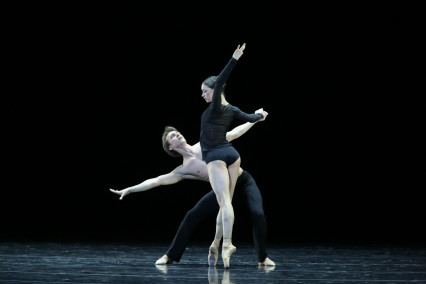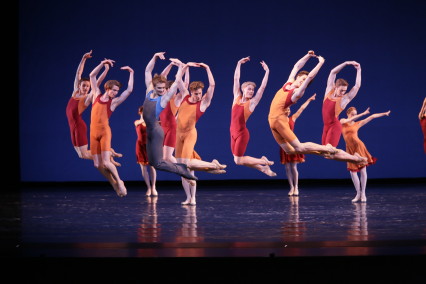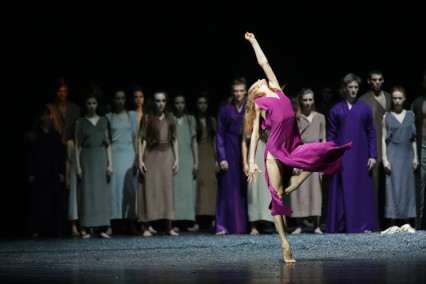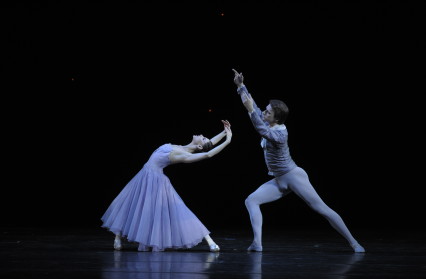Cath Barton is in Cardiff to cast a critical eye over the Mariinsky Ballet’s residency at the Wales Millennium Arts Centre.
The Mariinsky Ballet from St Petersburg is iconic. Many famous names in classical ballet are associated with it – choreographers Balanchine and Diaghilev, dancers Anna Pavlova, Vaslav Nijinsky and so on. The names of the dancers we see on today’s programmes may not be familiar to us, but they have been trained in a tradition dating back to 1783 when Empress Catherine II issued the imperial decree which led to the establishment of the company. That tradition and the rigour of their classical ballet training underpins the extraordinary standard of their work.
The five dance pieces which the company presented in this short residency in Cardiff were all in different styles and showcased the wide range of the dancers’ skills. The first programme was a triple bill, opening with Five Tangos (1977) from the Dutch choreographer, Hans Van Manen, to (in this instance, recorded) music by Astor Piazzolla. The curtain rose on a scene which took my breath away, dancers in red and black ranged on either side of the stage, figures of light and coiled energy dwarfed by a backdrop of high painted arches and pillars. A fusion of classical ballet and tango is almost a contradiction in terms, yet both require enormous control and the dancers certainly demonstrated that. To me the piece was like a musical box, the dancers puppets within it. It was always beautiful even though it did not carry the full sensuality of the tango. There was however a powerful male pas de deux from Boris Zhurilov and Alexei Tyutyunnik of the corps de ballet which stood out at the beating heart of the piece.

Infra (2008), created by British choreographer Wayne McGregor, is performed to music by electro-acoustic composer Max Richter, with live music from a piano and string ensemble. I found the LED screen above the stage showing walking figures distracting, apart from an arresting transition moment when the stage filled with dancers and extras (!) walking across, fleshing out the passage of the spectres above. This was a challenging piece – incredibly demanding physically for the dancers and difficult to absorb as a viewer because of its complexity. Nonetheless, a performance to be admired and containing moments of quiet intensity.
In contrast, In the Night (1970) charmed in its apparent and classic simplicity. Choreographed by Jerome Robbins, it was danced to Chopin’s Nocturnes for solo piano, here played by Liudmilla Sveshnikova. The performances from the pianist and the dancers were nothing less than pellucid and seamless. With a simple backdrop of stars and, for the second of the three pairs of dancers, starry chandeliers, this was something rarely exquisite and also strangely calming. The coda in which the three couples come together, having danced their separate relationships, was especially delightful.

The second programme was a double bill of dances to music by Russian composers. Choreographer Alexei Ratmansky, another son of St Petersburg, created Concerto DSCH (2008) to the exhilarating music of Shostakovich’s Piano Concerto No 2. Vladimir Rumyantsev, the piano soloist in this, gave a sparkling performance, most ably supported by the full forces of the Mariinsky Orchestra under the baton of their long-time director Valery Gergiev. The dancing matched the playing in vitality and vibrancy, with beautiful lyricism in the slow movement. This really came across as a piece about the joys of spring, and stood in contrast to the explosion of nature that was to follow it. Sacre (2013) was created for the Mariinsky Ballet by choreographer Sacha Waltz to mark the 100th anniversary of its music, Stravinsky’s The Rite of Spring. The choreography is as uncompromising as the music and, had it been danced 100 years ago, might have inspired the same sort of uncomprehending reactions as did Stravinsky’s music at its first performance.
The work opens in unspecified territory, at a time when humankind is young and the world still inchoate. In the centre of the stage is a small mound of dusty gravel. Gradually this is eroded but what replaces it is a kind of shard which descends from above. Quite what this symbolised escaped me, but there was no escaping the relentlessness of the piece. The dance was frenetic. I would have appreciated more passages of stillness from the dancers, the music whirling around and through them rather than carrying them back and forth across the stage exhaustingly. There were moments of welcome contrast, notably a striking passage, punctuated by drum rolls, in which the female dancers, each held aloft by a male partner in what was almost the position of a crucifixion, slithered to earth one by one.

At the climax of Sacre, Mariinsky Principal, Yekaterina Kondaurova, takes the part of the one who is chosen to be sacrificed to appease the God of Spring. The rest of the company stand and watch, as transfixed as the wider audience, as she gives herself up to the frenzy of the dance. It was a tour de force. The orchestra, expanded to about 90 strong, also gave their all.
It was a privilege to see this famous company dance. Impressive as they were throughout, it was their classical ballet skills which defined them for me, nowhere more so than in the exquisite pas de deux sequences of In the Night.
It was a good idea to include in this short residency a chance for the excellent Mariinsky Orchestra to be seen on stage. The performance of Prokofiev’s Peter and the Wolf and Tchaikovsky’s Nutcracker Suite was a lunchtime concert aimed at a family audience, and billed as being suitable for children aged 5+. There was a buzz in the auditorium as the audience gathered, with lots of young children there and seat risers available for them. Sadly, thereafter began the catalogue of errors. Keeping this audience waiting for 20 minutes was the first. Maestro Gergiev eventually coming on stage and lifting his baton without so much as ‘Hello’ to the audience, never mind anything about what they were about to hear, was the second. Playing the Tchaikovsky first and without any spoken introduction was the third.
Valery Gergiev did talk to the audience before Peter and the Wolf. He did introduce some of the instruments. He boldly took on the narration as he conducted. But he could have done more. If the three horn players had stood every time they came in as the wolf, for example, the children would have loved it. Some of them loved it anyway. Thank goodness, for they are the audience of the future. I asked a little girl behind me at the end what she thought of the performance and she said: “It was amAZing!” and told me that her favourites were the strings as Peter. But I had already gathered from chatting to her and her sister and parents beforehand that they knew the story of Peter and the Wolf and had heard the music lots of time before. Other children were clearly lost to boredom and restlessness well before the end of the Nutcracker Suite. What a shame.
Enough gripes. Overall, it is wonderful to have had the Mariinsky Ballet and Orchestra visit Cardiff. May they come back again and again.
Mariinsky Ballet and Orchestra
Artistic Director and Conductor: Valery Gergiev
Cardiff Residency
Wales Millenium Centre, 14 – 17 April 2016
Header photo: In the Night: Matvienko and Stepin © V. Baranovsky
Cath Barton won the New Welsh Writing AmeriCymru Prize for the Novella with The Plankton Collector, which is published by New Welsh Review under their Rarebyte imprint. Her second novella, In the Sweep of the Bay, will be published by Louise Walters Books in September 2020, and in early 2021 Retreat West Books will publish her collection of short stories inspired by the work of the Flemish artist Hieronymus Bosch.



 Enjoyed this article? Support our writers directly by buying them a coffee and clicking this link.
Enjoyed this article? Support our writers directly by buying them a coffee and clicking this link.







